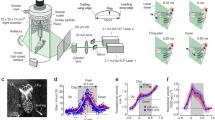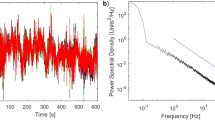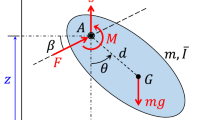Abstract
The flow structure that is largely responsible for the good performance of insect wings has recently been identified as a leading-edge vortex1,2. But because such vortices become detached from a wing in two-dimensional flow1, an unknown mechanism must keep them attached to (three-dimensional) flapping wings. The current explanation, analogous to a mechanism operating on delta-wing aircraft, is that spanwise flow through a spiral vortex drains energy from the vortex core3. We have tested this hypothesis by systematically mapping the flow generated by a dynamically scaled model insect while simultaneously measuring the resulting aerodynamic forces. Here we report that, at the Reynolds numbers matching the flows relevant for most insects, flapping wings do not generate a spiral vortex akin to that produced by delta-wing aircraft. We also find that limiting spanwise flow with fences and edge baffles does not cause detachment of the leading-edge vortex. The data support an alternative hypothesis—that downward flow induced by tip vortices limits the growth of the leading-edge vortex.
This is a preview of subscription content, access via your institution
Access options
Subscribe to this journal
Receive 51 print issues and online access
$199.00 per year
only $3.90 per issue
Buy this article
- Purchase on Springer Link
- Instant access to full article PDF
Prices may be subject to local taxes which are calculated during checkout



Similar content being viewed by others
References
Dickinson, M. H. & Götz, K. G. Unsteady aerodynamic performance on model wings at low Reynolds numbers. J. Exp. Biol. 174, 45–64 (1993).
Ellington, C. P. The aerodynamics of hovering insect flight. IV. Aerodynamic mechanisms. Phil. Trans. R. Soc. Lond. B 305, 79–113 (1984).
Ellington, C. P., Van den Berg, C., Willmott, A. P. & Thomas, A. L. R. Leading-edge vortices in insect flight. Nature 384, 626–630 (1996).
Van den Berg, C. & Ellington, C. P. The three-dimensional leading-edge vortex of a ‘hovering’ model hawkmoth. Phil. Trans. R. Soc. Lond. B 352, 329–340 (1997).
Sunada, S., Sakaguchi, A. & Kawachi, K. Airfoil section characteristics at low Reynolds number. J. Fluids Eng. 119, 129–135 (1997).
Kyia, M. & Arie, M. A contribution to an inviscid vortex-shedding model for an inclined flat plate in uniform flow. J. Fluid Mech. 82, 223–240 (1977).
Sarpkaya, T. An inviscid model of two-dimensional vortex shedding for transient and asymptotically steady separated flow over an inclined plane. J. Fluid Mech. 68, 109–128 (1975).
Dickinson, M. H., Lehmann, F. O. & Sane, S. P. Wing rotation and the aerodynamic basis of insect flight. Science 284, 1954–1960 (1999).
Willmott, A. P., Ellington, C. P. & Thomas, A. L. R. Flow visualization and unsteady aerodynamics in the flight of the hawkmoth Manduca sexta. Phil. Trans. R. Soc. Lond. B 352, 303–316 (1997).
Kücheman, D. The Aerodynamic Design of Aircraft (Pergamon, Oxford, 1978).
Maxworthy, T. Experiments on the Weis-Fogh mechanism of lift generation by insects in hovering flight Part 1. Dynamics of the ‘fling’. J. Fluid Mech. 93, 47–63 (1979).
Liu, H., Ellington, C. P., Kawachi, K., Van den Berg, C. & Willmott, A. A computational fluid dynamic study of hawkmoth hovering. J. Exp. Biol. 201, 461–477 (1998).
Dickinson, M. H. The effects of wing rotation on unsteady aerodynamic performance at low Reynolds numbers. J. Exp. Biol. 192, 179–206 (1994).
Wang, J. Two dimensional mechanism for insect hovering. Phys. Rev. Lett. 85, 2216–2219 (2000).
Milne-Thomson, L. M. Theoretical Aerodynamics (Macmillan, New York, 1966).
May, R. M. in Diversity of Insect Faunas (eds Mound, L. A. & Waloff, N.) 188–204 (Blackwell Scientific, London, 1978).
Dudley, R. The Biomechanics of Insect Flight. Form, Function, Evolution (Princeton Univ. Press, Princeton, 2000).
Willmott, A. P. & Ellington, C. P. The mechanics of flight in the hawkmoth Manduca sexta. II. Aerodynamic consequences of kinematic and morphological variation. J. Exp. Biol. 200, 2723–2745 (1997).
Acknowledgements
We thank C. Ellington, M. Gahrib, G. Lauder, S. Sane and J. Wang for comments and suggestions on this manuscript. This work was supported by the National Science Foundation, Office of Naval Research, and DARPA.
Author information
Authors and Affiliations
Corresponding author
Rights and permissions
About this article
Cite this article
Birch, J., Dickinson, M. Spanwise flow and the attachment of the leading-edge vortex on insect wings. Nature 412, 729–733 (2001). https://doi.org/10.1038/35089071
Received:
Accepted:
Issue Date:
DOI: https://doi.org/10.1038/35089071
This article is cited by
-
Improving depth uncertainty in plenoptic camera-based velocimetry
Experiments in Fluids (2024)
-
Continuous preparation of strong and tough PVA nanocomposite fibers by mechanical stretching-assisted salting-out treatment
Nano Research (2024)
-
Tensile mechanical properties and finite element simulation of the wings of the butterfly Tirumala limniace
Journal of Comparative Physiology A (2023)
-
Effect of wing flexibility on the aerodynamic performance of a robotic dragonfly
Archive of Applied Mechanics (2022)
-
Flight characteristics and flow structure of the autorotating maple seeds
Journal of Visualization (2022)
Comments
By submitting a comment you agree to abide by our Terms and Community Guidelines. If you find something abusive or that does not comply with our terms or guidelines please flag it as inappropriate.



